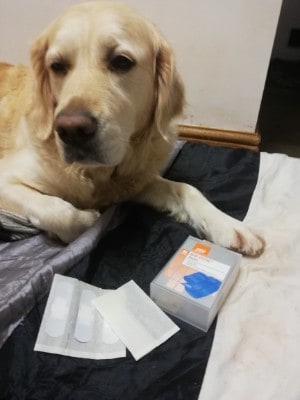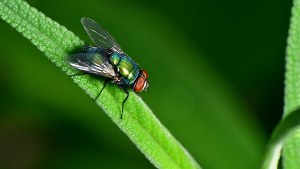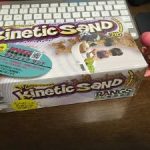
Hello! Welcome to another of my blog posts about some of the strange things that dogs eat.
And today’s focus is about dogs that have eaten band aids or plasters as we called them in the UK.
Just how dangerous is it for a dog to eat a band aid or something similar?
Is the real threat that the band aid might get stuck somewhere in the dog’s system or that sticking plasters might have a toxic ingredient in them that would make a dog unwell.
Let’s find out.
Size matters
Band aids come in a variety of sizes and the danger presented by eating a band aid depends on how big it was.
Now if for some strange reason your dog ate one of those band aids that people tend to apply to cut fingers or grazed knees then the chances of it doing your dog any harm is quite small.
If your dog ate a whole box of band aids that is also a completely different issue than eating just one.
Or if your dog ate a bigger and longer piece of vet wrap or adhesive bandage that had been applied somewhere on their own body, then that is a completely different kettle of fish!
So, let’s get straight to the point and answer you main concern…
My dog ate a band aid- what should I do?
If your dog eats one band aid then it is highly unlikely that they will come to any harm.
A small strip of sticking plaster is unlikely to get stuck in the throat or in a dog’s intestine and because it is soft, it won’t harm the lining of any of the dog’s digestion system as it moves along.
Because it is made from plastic, it won’t be digested by the dog and it will pass all the way through their system and out into their stool.
The exception to this will be if the adhesive on the underside of the plaster will get stuck in your dog’s throat or further down.
But, if it gets stuck in your dog’s throat then your dog will be coughing and retching in order to try and vomit in order to get the band aid out.
Hopefully, this will work and quickly your dog will vomit and within the nasty pile you will see the band aid.
The only thing that you should try to do is to give your dog some water, which might help the process.
Don’t be tempted to try and stick anything down your dog’s throat in order to get the band aid out.
As you could make things worse.
If your dog is still gagging or coughing after a few minutes, you must phone the vet and get some advice.
If your dog eats more than one band aid or a long length of adhesive bandage then the threat to your dog’s health is much greater.
The bandage will not be digested and again the best outcome is if your dog vomits it up quickly, or eats it and seems absolutely fine.
And then a couple of days later it comes out in their stool.
But, if you are lucky enough to have a dog that eats a long length of bandage that makes it all the way out in the stool, you might have to help.
Your dog will find passing the bandage very uncomfortable and so you might have to put on a pair of latex gloves and gently pull on the bandage to help it on its way.
If the bandage gets stuck, stop pulling it immediately and phone the vets.
There are plenty of examples of dogs eating long lengths of bandages and vet wrap and being none the worse for wear.
You can read some of these stories here and here.
And dogs that eat vet wrap or much longer pieces of bandage are in some ways it is very similar to “sock eating” dogs- many of whom seem none the worse for wear.
But there is a real danger that if your dog doesn’t vomit it up or the bandage can’t pass through their system that it will get stuck and block their intestine.
If this happens, you are looking for some big changes in your dog’s temperament.
He will go quiet and won’t want to do much.
If he eats, since his intestine is blocked, he will throw up partially digested food and he will have real trouble pooping.
No real surprise but if you start seeing any of this then you need to get an appointment with your vet, pronto!
Having discussed all the different scenarios that you might be up against if your dog has eaten any size or type of band aid or adhesive bandage, I now want to move on and look at what sticking plasters are made of and whether they contain anything that might be toxic to dogs.
What are most band aids made of?
Bandaids are made with four separate parts.
A top layer, a wound pad, an adhesive and a protective film over the adhesive.
Over time, the only part that has changed significantly is the material used for the top layer.
I think that traditionally, this top layer was made out of woven cotton or rayon fabric (which is derived from wood) with an adhesive applied to the underside of it.
But in recent years, band aids have become if not waterproof then moisture resistant and so are made out of plastics.
They are also breathable which speeds up the healing process.
[2] Is there anything toxic to dogs in band aids?
People who are allergic to band aids are most frequently allergic to a substance used in the adhesive.
It is called colophony or rosin and it is a mixture of substances derived from pine trees.
It is difficult to put an exact number on how many people have this allergy, but this sample thought that it could be as high as 4.5%.
It is almost unheard of in dogs- although I did read about a dog who seemed allergic to elastoplast (a brand of band aids.)
And so we can’t discount it completely.
And the signs that you are looking for are pretty standard for an allergic reaction.
These include a rash, hives or a burning or itching sensation.
You can try giving your dog an antihistamine tablet but only do this after seeking some advice from your vet.






